2017 KIA CARENS RHD steering
[x] Cancel search: steeringPage 14 of 723
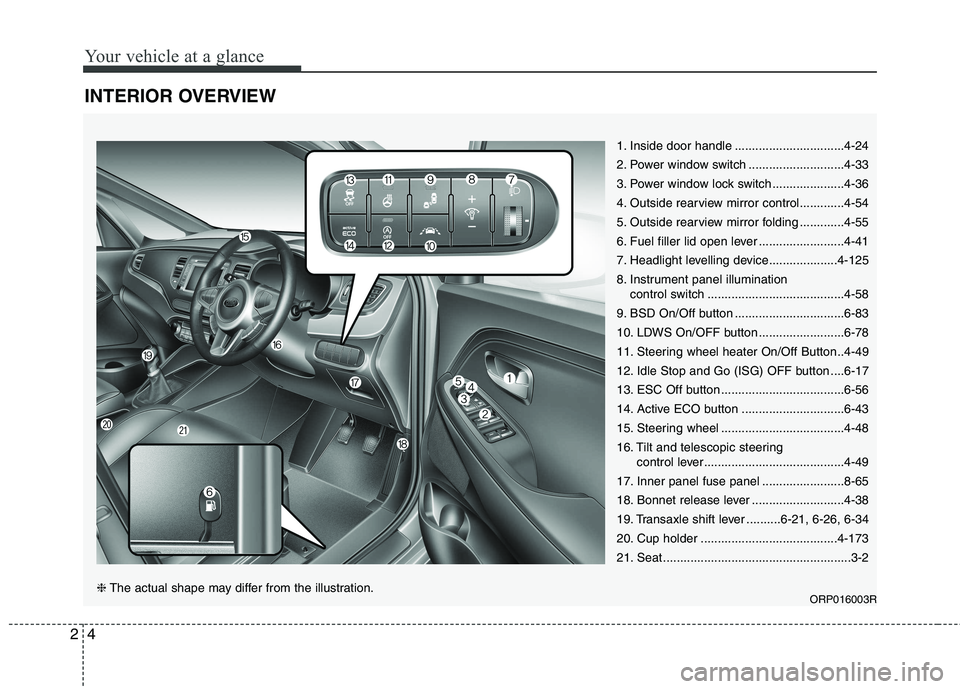
Your vehicle at a glance
4
2
INTERIOR OVERVIEW
1. Inside door handle ................................4-24
2. Power window switch ............................4-33
3. Power window lock switch .....................4-36
4. Outside rearview mirror control.............4-54
5. Outside rearview mirror folding .............4-55
6. Fuel filler lid open lever .........................4-41
7. Headlight levelling device....................4-125
8. Instrument panel illumination
control switch ........................................4-58
9. BSD On/Off button ................................6-83
10. LDWS On/OFF button .........................6-78
11. Steering wheel heater On/Off Button..4-49
12. Idle Stop and Go (ISG) OFF button ....6-17
13. ESC Off button ....................................6-56
14. Active ECO button ..............................6-43
15. Steering wheel ....................................4-48
16. Tilt and telescopic steering control lever.........................................4-49
17. Inner panel fuse panel ........................8-65
18. Bonnet release lever ...........................4-38
19. Transaxle shift lever ..........6-21, 6-26, 6-34
20. Cup holder ........................................4-173
21. Seat .......................................................3-2
ORP016003R
❈The actual shape may differ from the illustration.
Page 22 of 723

Safety features of your vehicle
4
3
(Continued)
In order to avoid unnecessary
and perhaps severe air bag
injuries, always sit as far back
as possible from the steeringwheel whilst maintaining
comfortable control of the
vehicle. It is recommended
that your chest is at least 250
mm (10 inches) away from thesteering wheel.WARNING - Driver’s seat
Never attempt to adjust seat whilst the vehicle is moving. This could result in loss of
control, and an accident caus-
ing death, serious injury, or
property damage.
Do not allow anything to inter- fere with the normal position of
the seatback. Storing items
against a seatback or in any
other way interfering with prop-
er locking of a seatback could
result in serious or fatal injury
in a sudden stop or collision.
Always drive and ride with your seatback upright and the lap
portion of the seat belt snug
and low across the hips. This
is the best position to protect
you in case of an accident.
(Continued)WARNING- Rear
seatbacks
The rear seatback must be securely latched. If not, passen-
gers and objects could be
thrown forward resulting in seri-
ous injury or death in the event
of a sudden stop or collision.
Luggage and other cargo should be laid flat in the cargo
area. If objects are large, heavy,
or must be piled, they must be
secured. Under no circum-
stances should cargo be piled
higher than the seatbacks.
Failure to follow these warnings
could result in serious injury or
death in the event of a sudden
stop, collision or rollover.
(Continued)
Page 25 of 723

37
Safety features of your vehicle
3. To use the front passenger’s seat,lift and pull the seatback backward
by pulling on the folding lever.
Pull the seatback firmly until it
clicks into place. Make sure the
seatback is locked in place.Seat cushion height (if equipped)
To change the height of the seat
cushion, push the lever upwards or
downwards.
To lower the seat cushion, push down the lever several times.
To raise the seat cushion, pull up the lever several times. Front seat adjustment - power (if equipped)
The driver’s seat can be adjusted by
using the control switches located onthe outside of the seat cushion.
Before driving, adjust the seat to theproper position so as to easily con-
trol the steering wheel, pedals and
switches on the instrument panel.
WARNING
Do not fold the front passen- ger’s seat, if the occupants in
the 2nd row centre and front
passenger’s side seats. It may
cause the injury to occupants
by the seat device.
Be careful not to pinch your hands or fingers on the seat
device, when you fold or unfold.
ORP036004R
WARNING
The power seat is operable with
the ignition OFF.
Therefore, children should never
be left unattended in the car.
Page 73 of 723
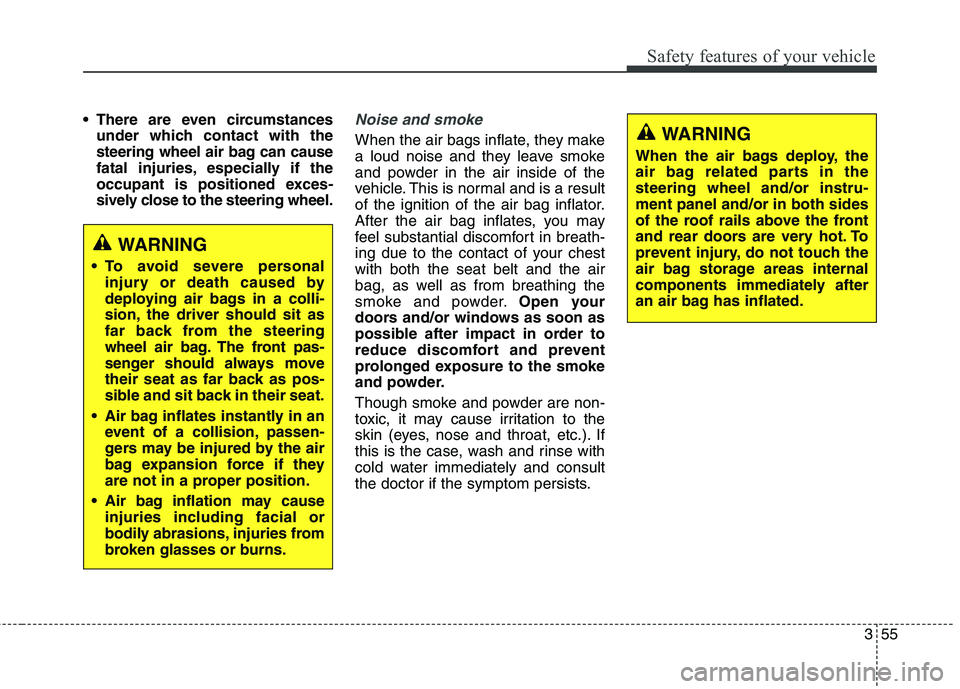
355
Safety features of your vehicle
There are even circumstancesunder which contact with the
steering wheel air bag can cause
fatal injuries, especially if the
occupant is positioned exces-
sively close to the steering wheel.Noise and smoke
When the air bags inflate, they make
a loud noise and they leave smoke
and powder in the air inside of the
vehicle. This is normal and is a result
of the ignition of the air bag inflator.
After the air bag inflates, you may
feel substantial discomfort in breath-
ing due to the contact of your chestwith both the seat belt and the air
bag, as well as from breathing the
smoke and powder. Open your
doors and/or windows as soon as
possible after impact in order to
reduce discomfort and prevent
prolonged exposure to the smoke
and powder.
Though smoke and powder are non-
toxic, it may cause irritation to the
skin (eyes, nose and throat, etc.). If
this is the case, wash and rinse with
cold water immediately and consult
the doctor if the symptom persists.
WARNING
To avoid severe personal injury or death caused by
deploying air bags in a colli-
sion, the driver should sit as
far back from the ste ering
wheel air bag. The front pas-
senger should always move
their seat as far back as pos-
sible and sit back in their seat.
Air bag inflates instantly in an event of a collision, passen-
gers may be injured by the air
bag expansion force if they
are not in a proper position.
Air bag inflation may cause injuries including facial or
bodily abrasions, injuries from
broken glasses or burns.
WARNING
When the air bags deploy, the
air bag related parts in thesteering wheel and/or instru-ment panel and/or in both sides
of the roof rails above the front
and rear doors are very hot. To
prevent injury, do not touch the
air bag storage areas internal
components immediately after
an air bag has inflated.
Page 78 of 723
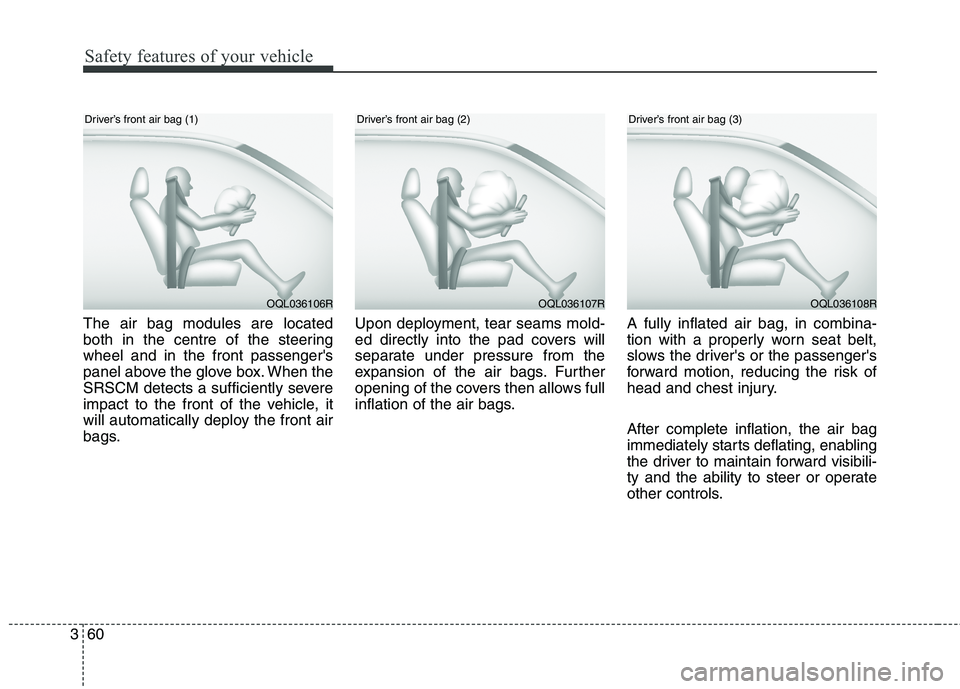
Safety features of your vehicle
60
3
The air bag modules are located
both in the centre of the steeringwheel and in the front passenger's
panel above the glove box. When the
SRSCM detects a sufficiently severe
impact to the front of the vehicle, it
will automatically deploy the front air
bags. Upon deployment, tear seams mold-
ed directly into the pad covers will
separate under pressure from the
expansion of the air bags. Further
opening of the covers then allows full
inflation of the air bags.
A fully inflated air bag, in combina-
tion with a properly worn seat belt,
slows the driver's or the passenger's
forward motion, reducing the risk of
head and chest injury. After complete inflation, the air bag
immediately starts deflating, enabling
the driver to maintain forward visibili-
ty and the ability to steer or operate
other controls.
OQL036106R
Driver’s front air bag (1)
OQL036107R
Driver’s front air bag (2)
OQL036108R
Driver’s front air bag (3)
Page 80 of 723
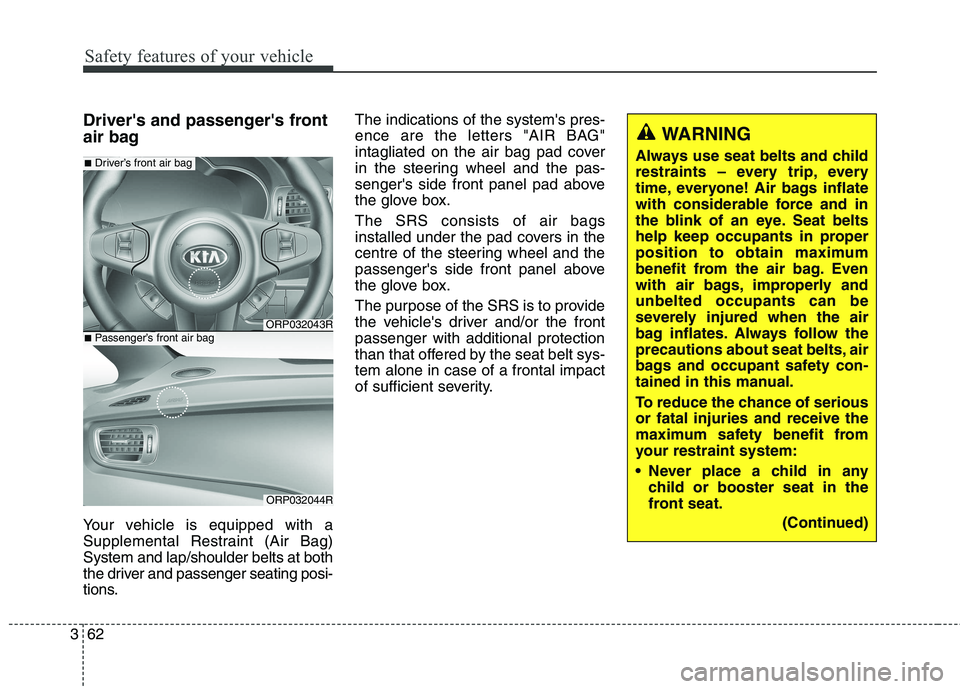
Safety features of your vehicle
62
3
Driver's and passenger's front
air bag
Your vehicle is equipped with a
Supplemental Restraint (Air Bag)System and lap/shoulder belts at both
the driver and passenger seating posi-
tions. The indications of the system's pres-
ence are the letters "AIR BAG"
intagliated on the air bag pad cover
in the steering wheel and the pas-
senger's side front panel pad above
the glove box. The SRS consists of air bags
installed under the pad covers in the
centre of the steering wheel and the
passenger's side front panel above
the glove box.
The purpose of the SRS is to provide
the vehicle's driver and/or the frontpassenger with additional protection
than that offered by the seat belt sys-tem alone in case of a frontal impact
of sufficient severity.
ORP032043R
■
Driver’s front air bag
ORP032044R
■Passenger’s front air bag
WARNING
Always use seat belts and child
restraints – every trip, every
time, everyone! Air bags inflate
with considerable force and in
the blink of an eye. Seat belts
help keep occupants in proper
position to obtain maximum
benefit from the air bag. Even
with air bags, improperly andunbelted occupants can be
severely injured when the air
bag inflates. Always follow the
precautions about seat belts, air
bags and occupant safety con-
tained in this manual.
To reduce the chance of serious or fatal injuries and receive the
maximum safety benefit from
your restraint system:
Never place a child in any child or booster seat in the
front seat.
(Continued)
Page 81 of 723
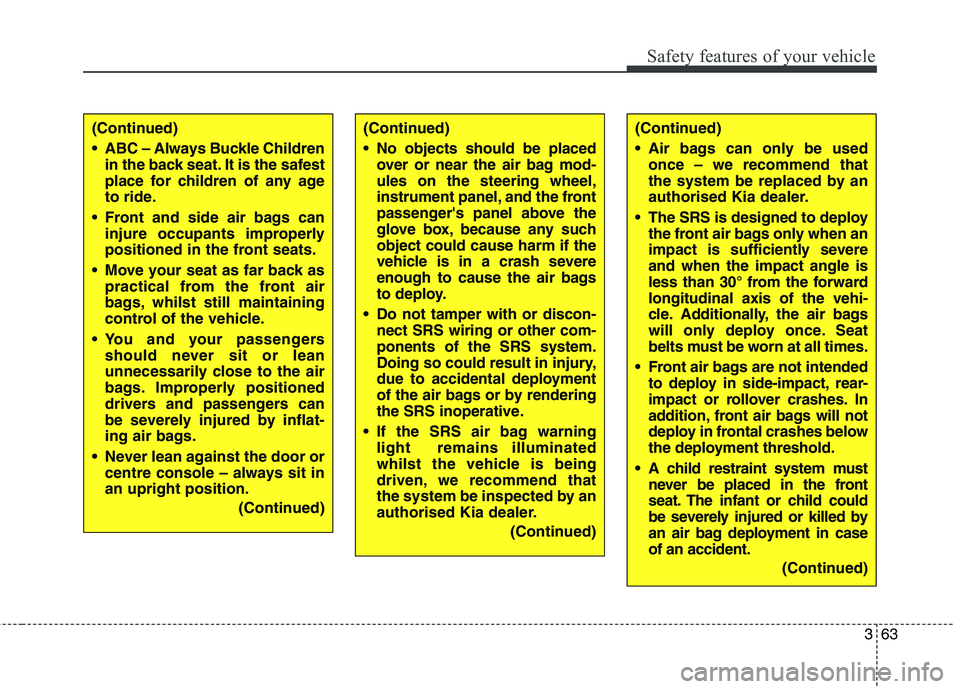
363
Safety features of your vehicle
(Continued)
ABC – Always Buckle Childrenin the back seat. It is the safest
place for children of any age
to ride.
Front and side air bags can injure occupants improperly
positioned in the front seats.
Move your seat as far back as practical from the front air
bags, whilst still maintaining
control of the vehicle.
You and your passengers should never sit or lean
unnecessarily close to the air
bags. Improperly positioned
drivers and passengers can
be severely injured by inflat-
ing air bags.
Never lean against the door or centre console – always sit inan upright position.
(Continued)(Continued)
No objects should be placedover or near the air bag mod- ules on the steering wheel,
instrument panel, and the front
passenger's panel above the
glove box, because any suchobject could cause harm if the
vehicle is in a crash severe
enough to cause the air bags
to deploy.
Do not tamper with or discon- nect SRS wiring or other com-ponents of the SRS system.
Doing so could result in injury,
due to accidental deployment
of the air bags or by rendering
the SRS inoperative.
If the SRS air bag warning light remains illuminated
whilst the vehicle is being
driven, we recommend that
the system be inspected by an
authorised Kia dealer.
(Continued)(Continued)
Air bags can only be usedonce – we recommend that
the system be replaced by an
authorised Kia dealer.
The SRS is designed to deploy the front air bags only when an
impact is sufficiently severeand when the impact angle is
less than 30° from the forwardlongitudinal axis of the vehi-
cle. Additionally, the air bags
will only deploy once. Seat
belts must be worn at all times.
Front air bags are not intended to deploy in side-impact, rear-
impact or rollover crashes. In
addition, front air bags will not
deploy in frontal crashes below
the deployment threshold.
A child restraint system must never be placed in the front
seat. The infant or child could
be severely injured or killed by
an air bag deployment in caseof an accident.
(Continued)
Page 85 of 723
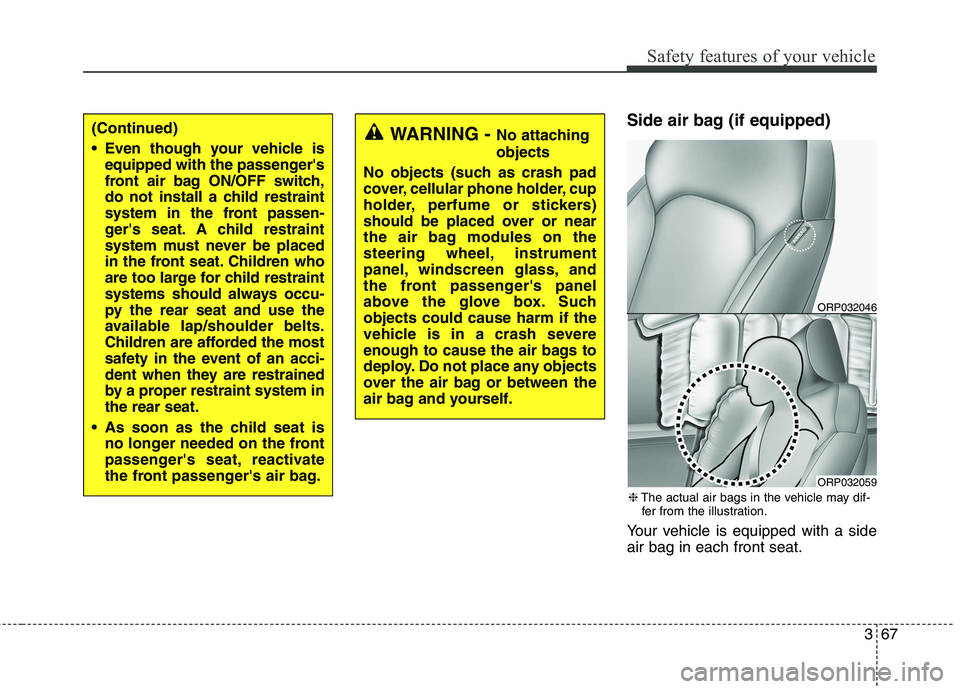
367
Safety features of your vehicle
Side air bag (if equipped)
Your vehicle is equipped with a side air bag in each front seat.(Continued)
Even though your vehicle isequipped with the passenger's
front air bag ON/OFF switch,
do not install a child restraint
system in the front passen-
ger's seat. A child restraint
system must never be placed
in the front seat. Children who
are too large for child restraint
systems should always occu-
py the rear seat and use the
available lap/shoulder belts.
Children are afforded the most
safety in the event of an acci-
dent when they are restrained
by a proper restraint system inthe rear seat.
As soon as the child seat is no longer needed on the front
passenger's seat, reactivate
the front passenger's air bag.WARNING - No attaching objects
No objects (such as crash pad
cover, cellular phone holder, cup
holder, perfume or stickers)
should be placed over or near
the air bag modules on the
steering wheel, instrument
panel, windscreen glass, and
the front passenger's panel
above the glove box. Suchobjects could cause harm if the
vehicle is in a crash severe
enough to cause the air bags to
deploy. Do not place any objects
over the air bag or between the
air bag and yourself.
ORP032046
ORP032059
❈ The actual air bags in the vehicle may dif-
fer from the illustration.